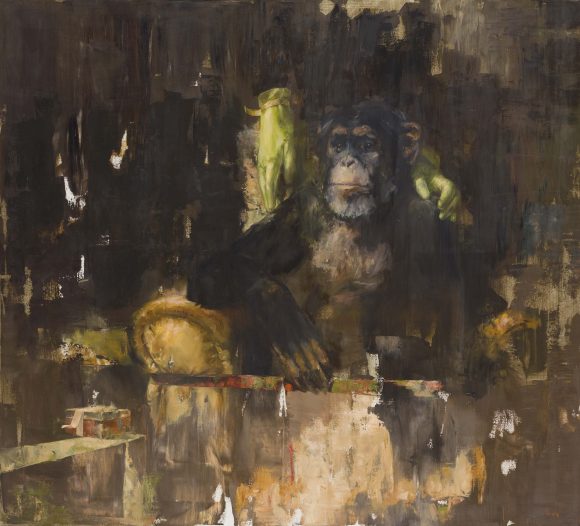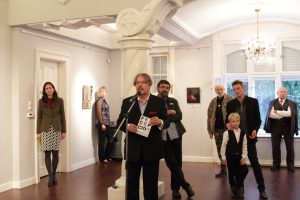„In Quarantine” by Mózes Incze was made for the thematic exhibition, Perceptions 3 – evolitio – . The artwork reflects on the roots of the human race, and on the close relationship between human and animal. On the picture there is a chimpanzee, who’s sitting comfortabely in an armchair with srtaight back. His attitude emphasizes his human strains. This could be the reason why he looks threatening to us. In researching the process of evolution, there is always the demand, to alienate ourselves from our animal progenitors. Our state of development rests on the differences, we separate ourselves from the class of monkeys. This portray of a chimpanzee by Mózes Incze obliterates thos differences. The painter sets the animal in the middle of the picture, as if it was a repesentative specimen to unveile the human race. He even surrounds it with a typical motive of his painting, a band. So the monkey is not in a cage, but it is under lock and key. From the dark background hands are leaning to the animal, wearing a pair of green gloves. The key of „In Quarantine” is how we describe the relationship between the monkey and the gloves. My interpretation calls the great philosopher, Walter Benjamin as help. According to him, touching an animal is a dangerous thing, because we can recognize ourselves in them. We have to keep our caveman-selves in secret, hide it, for example with a pair of gloves, which keep us out of touch with animals. But what if this gloves are made of leather? Aren’t we wearing a piece of what we want to desperately be released? On the left side of „In Quarantine” there is a little locked box. From this detail the whole painting can be interpreted as a box, that we use to hide, quarantine our caveman-selves. But is this something to be ashamed of? How does the whole problem look like in the opinion of an animal? The monkey of the painting may would use Nietzsche’s words: „An animal which could speak said: Humanity is a prejudice of which we animals at least are free.”
written by: Zsófi Máté
photo: misi
Mózes Incze: In Quarantine (100×110 cm, oil on canvas, 2015)














